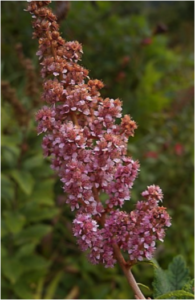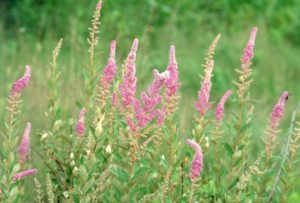Common Name: Steeplebush
Specific Name: Spiraea tomentosa
Known Occurrence at Taylor Point:
Map areas: Beach 1G
Category: Native, Shrub

Ecological Considerations:
Spiraea tomentosa, commonly known as Steeplebush, is 2-4′ tall, more or less erect shrub, and it is usually unbranched. The central stem is cylindrical, smooth, and brown; it is initially covered with woolly brown hairs, but later becomes hairless and woody. Alternate leaves are abundant along the stem; they are 1½–3″ long, ½–1¼” across, elliptic-oblong to ovate-oblong, somewhat leathery in texture, and coarsely toothed along their margins. The upper surfaces of the leaves are dark green and hairless, while their lower surfaces are more pale and covered with hairs that are tawny and woolly.
The central stem terminates in a dense panicle of pink flowers about 4-8″ long and about one-third as much across. The panicle has a narrowly pyramidal shape with short lateral branches that are ascending or spreading. Individual flowers are a little less than ¼” across, that are usually pink (less often white). The delicate petals are well-rounded and rather wrinkled. The blooming period occurs from mid-summer to early fall and lasts about 1-2 months. The abundant flowers bloom from the top of the panicle downward, gradually turning brown. There is no noticeable floral scent. Each flower is replaced by 5 small brown follicles that are ovoid with short beaks. Each follicle splits open at the apex to release several slender seeds. The root system is woody and branching.
Map areas where this plant can be used for revegetation:
Propagation Mechanisms/Strategies for Encouraging its Establishment:
Best Planting Practices/Options and Pros and Cons of Options:
Steeplebush preference is for full sun, wet to moist conditions, and an acidic sandy soil. The woody stems often die down to the ground during the winter.
Key Issues Regarding its Ecology
Associated Ecological Benefits:
Steeplebush’s flowers attract primarily bees, flies, and beetles The caterpillars feed on the flowers, buds, developing seed capsules, and leaves. Although White-Tailed Deer have been known to browse on Steeplebush, it is not preferred as a source of food because of the bitter and astringent foliage.
Availability of Locally Sourced Seeds and Plants:
Case Studies of Native Plant Establishment Efforts/Lessons Learned:
Additional photos:


Sources cited:
Search at Rhode Island Native Plant Guide
Illinois Wildflowers
Key Words:
Native
Shrub
Steeplebush
Spiraea tomentosa
